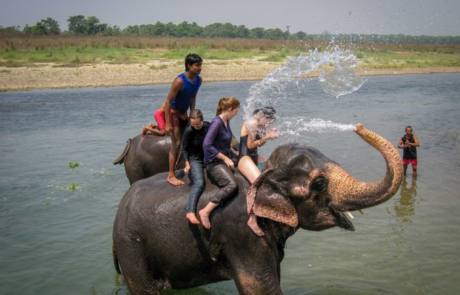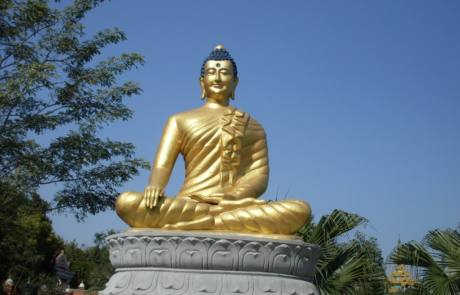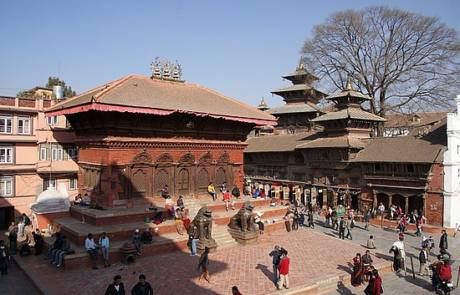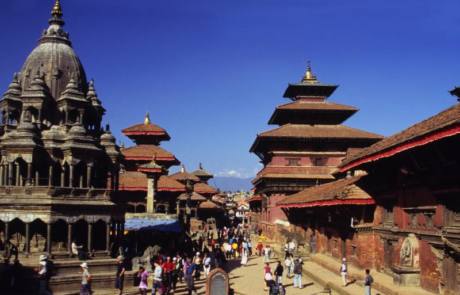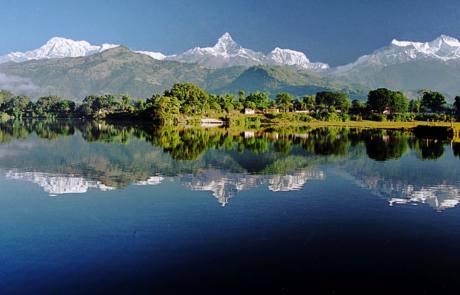11 DAYS/10 NIGHTS
NEPAL CULTURAL TOUR
Itinerary Summary
11 Days 10 Nights visiting Kathmandu, Chitwan, Lumbini, Dhulikhel
Nepal, the only country that is a Hindu state, boasts tremendous religious tolerance of the many faiths practiced within its borders.
Hinduists predominate in Nepal as 86.5% of the population. The next largest religious groups consist of Buddhists, 7.8%, and Muslims, 3.5% of the population. Common to all of these religions is the integration of religious expression within everyday life. In contrast with Western religions, these religions involve codes for individual behavior and daily rites of worship. In the morning, people gather at temples, sanctuaries, or river banks to offer prayers and puja.
Hinduism
The word Hinduism was introduced in the 19th century to define the aggregate beliefs of the Arya, immigrants who left Central Asia in 1500 BC, and the animist religions of native populations in India.
Basic concepts. Cosmic law rules the good order of the world, be aware of and respect cosmic law. Lead the life of a good Hindu, observe rules, perform all rites, and accept the caste of birth. The Caste system supplies a code of conduct and rites done. Encompasses all parts of life; rites but also who to take a drink from, associate with, marry, etc.
Principles of Hinduism. Dharma religious law and moral code by which people can earn enlightenment. Karma is the life balance of action and reaction; individuals are responsible for decisions and consequences. Leading good Hindu life will bring rebirth into a better life. Samsara is a cycle of reincarnations determined by karma. Moksha is liberation from samsara; individual unites with universal timelessness, ultimate serenity, and nirvana. Path to moksha is good Hindu life.
Each deity has different names, as well as different symbols, attributes, tasks, and powers according to what god it represents. Each deity has a vehicle, an animal usually serves a master. Primary Hindu gods are Brahma, Vishnu, and Shiva.
Brahma is the creator of the universe. Attributes are the rosary, the receptacle of holy water, the ladle, and the book. Mount is a goose or swan. Brahma usually represented with four heads, allows him to watch over the world. Very few statues of Brahma since creation is done.
Saraswati is Brahma’s consort and is the goddess of knowledge, learning, and music. She is often portrayed with four arms, playing the veena (seven-stringed musical instrument) with two hands as well as holding a rosary and a book. Sits on a lotus riding a peacock or a swan. Often a crescent moon on the forehead. Worshipped by Buddhists as a form of Manjushri, the Bodhisattva of wisdom.
Vishnu is the preserver of life and the world. Attributes are the conch shell, the disc, the lotus, and the mace. Mount is Garuda, a mythical half-man and half-bird.
Pre-departure planning is important.
Here are certain things you should watch for and plan for.
Visas
Check with the Nepal consulate or embassy in your country or you can get Visa on arrival as well to find out if you will need a visa to visit the country of your destination, especially for an extended period of time. Some countries have extremely detailed and complicated entry/departure laws and treat visits of a week or two very differently from longer stays.
Money
If you’re traveling to one area, check the cost of living there. If it’s high you’ll probably want to budget more carefully and save some money before leaving. The lower the cost of living the less you’ll have to save, but be sure to have a backup reserve in emergency cases.
General Tips
Talk to other people who have done a similar trip.
If you don’t know anyone personally, try any of the dozens of online travel websites full of first-person travel stories covering every possible type of trip.
Plan big and loose. Read everything you can about the area.
There may be sights and attractions you didn’t know about. A rough outline of your trip might have three or four target points and a variety of ways to get between them.
You don’t want to find out that the weather isn’t what you thought, or the guidebook was incorrect, after committing to 6 weeks in a specific spot.
Some trips will allow you more leeway than others. Travel plans in Asia can often be made day-by-day while summer travel in Europe should be organized at least a few weeks ahead unless you’re prepared to hunt around for hotel rooms and train seats.
Set up a pre-trip timeline so you don’t end up with a full to-do list during your last week of work or school.
Things to consider are doctor’s visits for a check-up, inoculations, and prescription refills; purchasing plane tickets; renewing passports, and obtaining visas and other documents.
Check your insurance coverage abroad and purchase additional travel insurance if needed. Don’t forget to visit friends and family members!
The longer the trip, the lighter you should pack. This might seem strange, but it’s true you can afford to lug a heavy bag around for a week or two, but do you want to have anything extra for a year?
Stick to the absolute basics and know what you can and cannot buy at your destination(s). There’s no point in bringing 6 months of toothpaste to Europe or buying a sarong at home to take to the tropics. If you are visiting several climates, try to arrange it so you visit the warmer places first and the coldest last. That way you can purchase sweaters and long pants and not have to carry them any more than needed. Alternately, visit cold climates first and then ship unneeded layers home — or sell them off.
A good rule of thumb is to bring one outfit for the hottest day you’re likely to encounter, one for an average day, and one for the coldest.
Make sure everything goes with everything else (if that’s important to you), and remember that layers are always best.
Be prepared for uncomfortable trips. You will often find yourself in a busy, cramped, economy class environment and it could be for many hours – especially long plane trips.
If you want to arrive at your destination refreshed and able to enjoy the sights, then try a good quality travel pillow to support your head, some earplugs to block out the screaming babies, and an eye cover to block out the sun or cabin lights.
Just avoid those cheap U-shaped pillows from airport shops – your head drops forward and you wake up with a stiff neck.
Make contact with the locals before you go.
Maybe you have a friend-of-a-friend or a foreign exchange student from high school you remember, or just found a friend through a travel website; almost everyone is happy to welcome a foreign visitor to their hometown. This might be as elaborate as a home stay for a few weeks, or just coffee in their hometown or dinner at a local restaurant.
Trip Attractions
Visit Bhaktapur, Bodhnathnath, Pashupatinath at Kathmandu.
Visit Chitwan National Park at Subarnapur.
Elephant Ride at Chitwan National Park.
Visit various monasteries at Lumbini .
Travel Resources
Travel planning is about more than just knowing where you’re going. Prepares to navigate, take control and be ready for anything. This section helps you steer clear of disaster and stay open to enjoy the unexpected.
Quick Tips
- Banks – Open Monday to Friday 9 am to 2 pm. Some banks are closed for lunch.
- Emergencies – For police, dial a local phone number; for an ambulance call a hospital.
- Internet Access – Wifi is standard in most hotels and free in many coffee shops.
- Mail – Buy stamps at the Post Office. Convenient post offices have located in all major cities of Nepal. Most are open Sunday to Friday 9 am to 3 pm as Saturday is Holiday In Nepal.
- Safety – Pickpocketing can be a common problem. It is suggested for men to keep wallets in their front pockets. Purse snatching also occurs at times.
Visitor Information
This site contains information with a very personal and friendly structure. It also has great links to other related sites online.
Information, internet access, maps, and train passes are available at local Tourist Information terminals. These are located at various sites around the city. Expect a wait if you arrive late in the afternoon or during lunchtime. Local travel agencies are also helpful for quick information and finding hotels. There is no service charge for these services. Hours are Monday to Friday 9 am to 5 pm, and Saturday 10 am to 2 pm.
Transportation
Getting in from the airport and other arrival locations. Travel planning is about more than just knowing where you’re going. Prepares to navigate, take control and be ready for anything. This section helps you steer clear of disaster and stay open to enjoy the unexpected.
- Plane – Flights arrive at the main airport near the city center. If flying from European cities, you might land at a connecting airport. There is a tourist information office at the Terminal, international arrivals, open 8 am to 6 pm.
- Taxi – From the airport, there is a flat rate for the 1-hour trip, depending on traffic.
- Bus – Trains and buses arrive at the city center. This is the transportation hub for the city and is surrounded by hotels.
A perfect place for exploring on foot, with local shops around every corner. You will eventually walk somewhere, it’s just going to happen. If you don’t like crowds, uneven cobblestones, heavy traffic, or narrow sidewalks, take a taxi or rent a scooter.
Itinerary Details
Day 1: Kathmandu
You will be met by our representatives and transferred to your hotel, welcome drink at the hotel. Overnight stay at Kathmandu.
Day 2: Kathmandu
Sightseeing tour of Bhaktapur, Bodhnathnath, Pashupatinath & the Kathmandu Durbar Square. Overnight stay at Kathmandu.
Day 3: Kathmandu
Half-day sightseeing tour of Swayambhunath & Patan. Overnight stay at Kathmandu.
Day 4: Kathmandu – Chitwan National Park
Early morning drive to the Chitwan National Park. At the lodge, the Jungle Guide will brief you on Asia’s biggest game reserve. Overnight stay at lodge in Chitwan.
Day 5: Chitwan National Park
Safari activities Include an Elephant ride into the jungle for excellent game viewing, a Jungle walks, Canoe ride. Later in the evening, a Cultural dance will be performed by the local inhabitants – The Tharu. Overnight stay at lodge in Chitwan.
Day 6: Chitwan National Park – Lumbini
Early morning Bird Watching tour. After breakfast, proceed to Lumbini – The birthplace of Lord Buddha. Overnight stay at Lumbini.
Day 7: Lumbini
Full-day tour of Lumbini. Visit the sacred place where Princess Maya Devi gave birth to Lord Buddha and various monasteries. Overnight stay at Lumbini.
Day 8: Lumbini – Kathmandu
Fly to Kathmandu. You will be transferred to Dhulikhel, a scenic village famous for its views of the snow-capped mountains. Overnight at Hotel.
Day 9: Kathmandu ( Everest Flight )
View the sunrise and the Himalayan ranges. Later in the afternoon, transfer to Kathmandu. Overnight stay at Kathmandu.
Day 10: Kathmandu
Free day in Kathmandu for shopping and relaxation. Overnight stay at Kathmandu.
Day 11: Kathmandu ( Departure )
The day is free until your transfer to the airport for your onward flight.

